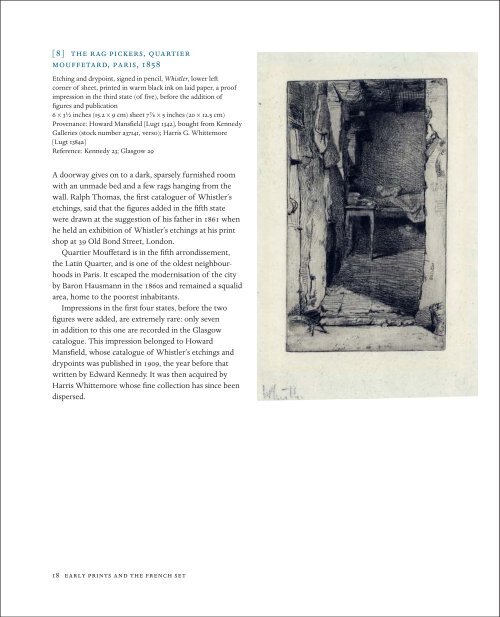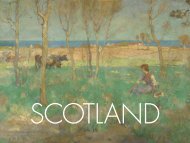Create successful ePaper yourself
Turn your PDF publications into a flip-book with our unique Google optimized e-Paper software.
[8] the Rag Pickers, Quartier<br />
Mouffetard, Paris, 1858<br />
Etching and drypoint, signed in pencil, Whistler, lower left<br />
corner of sheet, printed in warm black ink on laid paper, a proof<br />
impression in the third state (of five), before the addition of<br />
figures and publication<br />
6 x 3 1/2 inches (15.2 x 9 cm) sheet 7 7/8 x 5 inches (20 x 12.5 cm)<br />
Provenance: Howard Mansfield [Lugt 1342], bought from Kennedy<br />
Galleries (stock number a37141, verso); Harris G. Whittemore<br />
[Lugt 1384a]<br />
Reference: Kennedy 23; Glasgow 29<br />
A doorway gives on to a dark, sparsely furnished room<br />
with an unmade bed and a few rags hanging from the<br />
wall. Ralph Thomas, the first cataloguer of Whistler’s<br />
etchings, said that the figures added in the fifth state<br />
were drawn at the suggestion of his father in 1861 when<br />
he held an exhibition of Whistler’s etchings at his print<br />
shop at 39 Old Bond Street, London.<br />
Quartier Mouffetard is in the fifth arrondissement,<br />
the Latin Quarter, and is one of the oldest neighbourhoods<br />
in Paris. It escaped the modernisation of the city<br />
by Baron Hausmann in the 1860s and remained a squalid<br />
area, home to the poorest inhabitants.<br />
Impressions in the first four states, before the two<br />
figures were added, are extremely rare: only seven<br />
in addition to this one are recorded in the Glasgow<br />
catalogue. This impression belonged to Howard<br />
Mansfield, whose catalogue of Whistler’s etchings and<br />
drypoints was published in 1909, the year before that<br />
written by Edward Kennedy. It was then acquired by<br />
Harris Whittemore whose fine collection has since been<br />
dispersed.<br />
[9] Seymour, 1858–59<br />
Etching and drypoint, signed in pencil Whistler, lower right<br />
and inscribed Seymour, lower left; inscribed in pencil by Francis<br />
Seymour Haden in lower margin 1st pr from plate, printed in warm<br />
black ink on fine laid paper, watermark hunting horn in shield; in<br />
the second state (of three): there was no published edition<br />
5 1/4 x 3 7/8 inches (13.5 x 9.9 cm)<br />
sheet 7 1/8 x 5 5/8 inches (18.1 x 14.3 cm)<br />
Provenance: Kennedy Galleries, New York (their stock number<br />
in pencil on verso a37155); Ethel Gardner; a gift in memory of her<br />
husband George Peabody Gardner (nephew and heir of Isabella<br />
Stewart Gardner) to Bishop Laurence of the Archdiocese of<br />
Boston; George S. van Houten, Waalre, Netherlands<br />
Reference: Kennedy 31; Glasgow 30<br />
The young boy leaning against a tree in contemplative<br />
pose, possibly in Greenwich Park in London, with his<br />
partial reflection visible on the surface of the water in<br />
the foreground, is Francis Seymour Haden, Jr. (1850–<br />
1918), the eldest son of Whistler’s half-sister, Deborah<br />
Delano Haden, and her husband Francis Seymour<br />
Haden, Sr. Young Seymour posed for two other portrait<br />
etchings by Whistler: Seymour, Standing (1857–1858; K.6)<br />
and Seymour Haden, Jr., Seated (1857–1858; K.29). The<br />
couple had another son, Arthur Charles (1852–1910) and<br />
a daughter, Anne Harriet, known as Annie (1848–1937),<br />
both of whom were also portrayed by their uncle in several<br />
etchings. In 1858 and 1859, Whistler visited his sister<br />
and her family at their house in Sloane Street, London<br />
from Paris; as the Glasgow catalogue suggests, the leafy<br />
trees and the light clothing of the boy suggest a date of<br />
fall 1858 or spring 1859 for the etching, which the artist<br />
may have initially drawn in the open air.<br />
The boy is wearing typical Victorian boy’s dress, with<br />
a high bonnet and a knee-length kilt or skirt, long socks,<br />
and lace-up shoes. While the execution of the work is<br />
somewhat stiff and illustrational in style, it points to<br />
Whistler’s preoccupation throughout his career with<br />
reflection, both mental and physical. He was later to elaborate<br />
on the latter with an exceptionally nuanced sophistication<br />
in his watery scenes of Venice and Amsterdam.<br />
18 EARLY printS and THE FRENCH SET james mcneill whistler: prints 19



